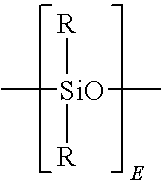Polycarbonate-polysiloxane copolymer compositions and articles formed therefrom
a polysiloxane and polycarbonate technology, applied in the field of polycarbonates, can solve the problems of increased haze in the composition, brittleness of polycarbonates, and low ductility of polycarbonates
- Summary
- Abstract
- Description
- Claims
- Application Information
AI Technical Summary
Benefits of technology
Problems solved by technology
Method used
Image
Examples
examples 1-8
[0122 and Comparative Examples 1-3 were formulated as described in Table 2 using 100 parts by weight of mixtures of the above resins, 0 to 0.4 parts per hundred (phr) PETS, and 0 to 0.10 phr I-168. The resins and additives were formulated in a HENSCHEL-Mixer® tumbler for 5 to 10 minutes. Then, the formulations were extruded on a twin-screw extruder and pelletized. The pellets were injection molded into samples for analysis. Table 2 displays the resin formulations and the corresponding properties of the pellets and injection-molded parts. All formulations were amorphous and transparent to the naked eye.
[0123]
TABLE 2MVR,23° C. NI23° C.PC-I-PC-I-300° C. / 1.2 KgImpactDynatup23° C. Dynatup5086PC-SiLoadStrengthTotalDuctility (%Entry(wt %)(wt %)(wt %)(cm3 / 10 min))(J / m)Energy (J)of samples)Ex. 1a082.317.79.926.781.580Ex. 2a029.570.511640.883.6100Ex. 3a058.841.211.442.773.760Ex. 4b040601232.062.9100Ex. 5b0604013.321.461.160Comp.0802013.916.02.50Ex. 1bEx. 6c7003018.310.7N / AN / AEx. 7c8002019.521...
PUM
| Property | Measurement | Unit |
|---|---|---|
| total energy | aaaaa | aaaaa |
| thickness | aaaaa | aaaaa |
| Rg | aaaaa | aaaaa |
Abstract
Description
Claims
Application Information
 Login to View More
Login to View More - R&D
- Intellectual Property
- Life Sciences
- Materials
- Tech Scout
- Unparalleled Data Quality
- Higher Quality Content
- 60% Fewer Hallucinations
Browse by: Latest US Patents, China's latest patents, Technical Efficacy Thesaurus, Application Domain, Technology Topic, Popular Technical Reports.
© 2025 PatSnap. All rights reserved.Legal|Privacy policy|Modern Slavery Act Transparency Statement|Sitemap|About US| Contact US: help@patsnap.com



